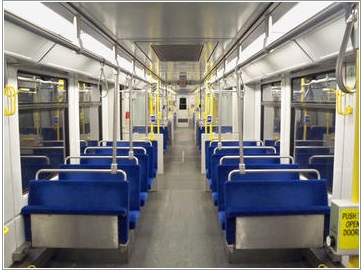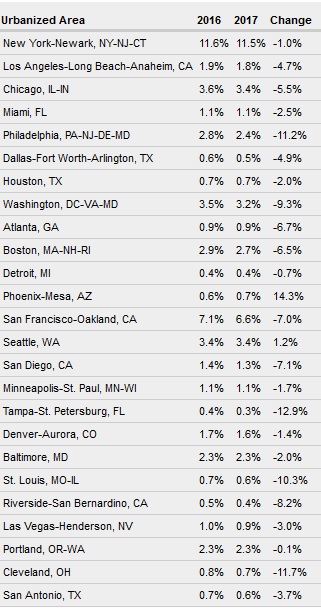
Transit’s Declining Importance
by Randal OToole
03/27/2019
http://www.newgeography.com/content/006256-transit-s-declining-importance

The steady decline in transit ridership, combined with the growth
of driving, is revealed in passenger-mile data published by the Department of
Transportation. The table below shows changes in transit’s share of motorized
travel for the nation’s 25 largest urban areas. Outside of these areas,
transit’s share declined by more than 10 percent in Sacramento, San Jose,
Indianapolis, Milwaukee, and Charlotte, among many others.

These calculations were made possible by the Federal Highway Administration’s release of table HM-72 for the 2017 Highway Statistics. This table shows the number of vehicle miles traveled (VMT) per day by urbanized area. Multiply daily VMT by 365 to get annual VMT, then by average auto occupancies of 1.67 (based on the National Household Travel Survey) to get annual passenger miles. This can be compared with passenger miles from the 2017 National Transit Database, which was released last October.
You can download the Antiplanner’s updated summary of the 2017 National Transit Database to get my calculations of transit’s share of travel. I copied the daily VMT from table HM-72 into cells AR3881 through AR4367, converted to passenger miles in the adjacent (AS) column, and calculated transit’s share in the AT column. Transit passenger miles are in column L. A handful of urban areas (such as Nampa, Idaho) are in the National Transit Database but not Highway Statistics, while two (Norman, OK and Middletown, NY) are in Highway Statistics but not the National Transit Database.
Among the nation’s 50 largest urban areas, transit share grew only in Phoenix, Seattle, Cincinnati, Virginia Beach, Austin, Richmond, and Hartford. Except in Phoenix, where transit’s share is less than 1 percent, transit’s growth in these urban areas was tiny.
Meanwhile, the 5 to 11 percent declines in Boston, Chicago, Philadelphia, San Francisco-Oakland, and Washington — in all of which transit remains somewhat important — are devastating. Ride hailing is clearly particularly strong in these regions.
Ironically, the San Francisco Chronicle recently listed the Bay Area’s 11 biggest transportation projects: two were bike routes, two were highways, while the remaining seven were transit. Obviously, the region’s transportation planners are basing priorities on wishful thinking.
Counting all 480-some urban areas, transit carries less than 1.6 percent of urban travel. Transit carries more than 1 percent of travel in only 38 urban areas, and more than 2 percent in just 14. The Federal Transit Administration doesn’t require smaller transit agencies to estimate passenger miles, so many smaller urban areas are reported as having a zero percent transit share. In most if not all of these areas, the real number is between zero and 1 percent.
The raw numbers indicated that transit carried more than 10 percent of travel — about the same as New York — in the small community of Hanford, California. That’s deceptive, however, as the California Vanpool Authority, which oversees vanpooling in 18 counties, is headquartered in Hanford. Correcting for that reduces transit’s share in Hanford to a more likely 0.5 percent.
For what it’s worth, I also added up passenger miles of travel by state in rows 4376 to 4427. Column AR is millions of annual VMT from Highway Statistics table VM-2. Column AS converts this to thousands of passenger miles and column AT shows transit’s share. Transit passenger miles are based on the states in which transit agencies are headquartered, so there will be some errors where major agencies (such as New Jersey Transit) cross state lines. Transit agencies in Wyoming are among those that don’t report passenger miles, so transit’s share appears to be zero there. Even though it’s not really zero, it is still very low.
These numbers show that transit is not a vital part of any urban area except New York. While transit plays an important role in bringing commuters into the downtowns of a few other major cities — namely Boston, Chicago, Philadelphia, San Francisco, Seattle, and Washington — even in those cities its importance is declining. Outside of the downtown commuters in those cities, transit is practically irrelevant.
This piece originally appeared on The Antiplanner.
Randal O’Toole is the director of the Independence Institute’s Transportation Policy Center and author of the recent book, Romance of the Rails: Why the Passenger Trains We Love Are Not the Transportation We Need.
Photo: Anthonyramos1 at English Wikipedia [CC BY-SA 3.0], via Wikimedia Com